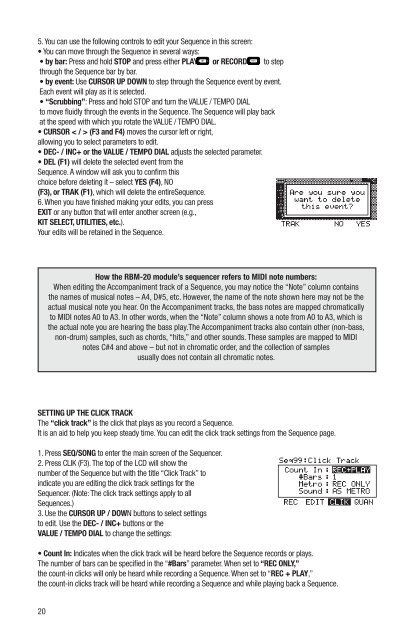Pearl Redbox RBM 20 Module Owner's Manual v
Pearl Redbox RBM 20 Module Owner's Manual v
Pearl Redbox RBM 20 Module Owner's Manual v
Create successful ePaper yourself
Turn your PDF publications into a flip-book with our unique Google optimized e-Paper software.
5. You can use the following controls to edit your Sequence in this screen:<br />
• You can move through the Sequence in several ways:<br />
• by bar: Press and hold STOP and press either PLAY or RECORD to step<br />
through the Sequence bar by bar.<br />
• by event: Use CURSOR UP DOWN to step through the Sequence event by event.<br />
Each event will play as it is selected.<br />
• “Scrubbing”: Press and hold STOP and turn the VALUE / TEMPO DIAL<br />
to move fluidly through the events in the Sequence. The Sequence will play back<br />
at the speed with which you rotate the VALUE / TEMPO DIAL.<br />
• CURSOR < / > (F3 and F4) moves the cursor left or right,<br />
allowing you to select parameters to edit.<br />
• DEC- / INC+ or the VALUE / TEMPO DIAL adjusts the selected parameter.<br />
• DEL (F1) will delete the selected event from the<br />
Sequence. A window will ask you to confirm this<br />
choice before deleting it – select YES (F4), NO<br />
(F3), or TRAK (F1), which will delete the entireSequence.<br />
6. When you have finished making your edits, you can press<br />
EXIT or any button that will enter another screen (e.g.,<br />
KIT SELECT, UTILITIES, etc.).<br />
Your edits will be retained in the Sequence.<br />
How the <strong>RBM</strong>-<strong>20</strong> module’s sequencer refers to MIDI note numbers:<br />
When editing the Accompaniment track of a Sequence, you may notice the “Note” column contains<br />
the names of musical notes – A4, D#5, etc. However, the name of the note shown here may not be the<br />
actual musical note you hear. On the Accompaniment tracks, the bass notes are mapped chromatically<br />
to MIDI notes A0 to A3. In other words, when the “Note” column shows a note from A0 to A3, which is<br />
the actual note you are hearing the bass play.The Accompaniment tracks also contain other (non-bass,<br />
non-drum) samples, such as chords, “hits,” and other sounds. These samples are mapped to MIDI<br />
notes C#4 and above – but not in chromatic order, and the collection of samples<br />
usually does not contain all chromatic notes.<br />
SETTING UP THE CLICK TRACK<br />
The “click track” is the click that plays as you record a Sequence.<br />
It is an aid to help you keep steady time. You can edit the click track settings from the Sequence page.<br />
1. Press SEQ/SONG to enter the main screen of the Sequencer.<br />
2. Press CLIK (F3). The top of the LCD will show the<br />
number of the Sequence but with the title “Click Track” to<br />
indicate you are editing the click track settings for the<br />
Sequencer. (Note: The click track settings apply to all<br />
Sequences.)<br />
3. Use the CURSOR UP / DOWN buttons to select settings<br />
to edit. Use the DEC- / INC+ buttons or the<br />
VALUE / TEMPO DIAL to change the settings:<br />
• Count In: Indicates when the click track will be heard before the Sequence records or plays.<br />
The number of bars can be specified in the “#Bars” parameter. When set to “REC ONLY,”<br />
the count-in clicks will only be heard while recording a Sequence. When set to “REC + PLAY,”<br />
the count-in clicks track will be heard while recording a Sequence and while playing back a Sequence.<br />
<strong>20</strong>


